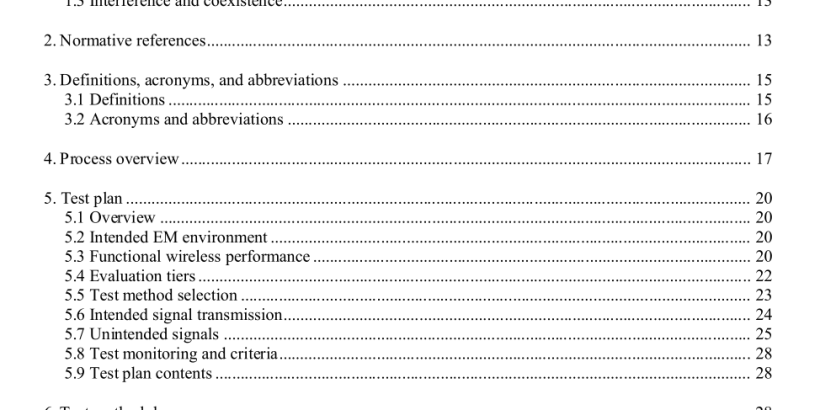ANSI C63.27-2017 pdf download.American National Standard for Evaluation of Wireless Coexistence
5.5.2 EUT special functionality
The EUT could have special functionality to enhance its capabilities, such as multiple-input, multiple-output (MIMO), beam forming, or simultaneous transmissions that need to be tested for coexistence, which require special methods to test these systems. Multiple antenna usage by EUTs should be tested in both line-of-sight (LOS) and non-line-of-sight (NLOS), where EUTs can mitigate LOS interference by using NLOS paths, and vice versa. ROE test methods are the preferred method, implementing NLOS and LOS. Conducted methods can be implemented; however, phasing of the two or more antennas with interference and signals can become complex. K nowing whether the EUT has MIMO and understanding how this can mitigate interference can help in test method selection. Multipath of the wireless communication signal should be taken into account during coexistence testing, especially for multiple antenna wireless technologies such as IEEE 802.11n. The use of multiple antennas offers extended range, improved reliability, and higher throughputs than conventional single -antenna communication systems. Other antenna-based systems use multiple transmit and receive antennas to provide diversity gain in a fading (multipath) environment, antenna gain, and interference suppression. These gains translate into improvement of the spectral efficiency, range, and reliability of wireless networks. Neglecting multipath in coexistence testing reduces the depth of the evaluation of the EUT.
5.6.1 Intended signal level
The test plan shall specify the intended signal level at the EUT and the EUT companion device (if applicable) for coex istence testing. The intended signal level shall be documented in the test report, typically in dBm or dBm/MHz, and verified by measurement during testing. To reduce the number of test runs, it is suggested that the intended signal level be selected for a reasonable worst-case scenario. The in tended signal level can be related to the operational distance between the EUT and its companion device if the path loss between them can be determined; see 6.2.3 for further discussion of path loss. The frequencies, modulations, RF transmit power levels, and power control of the EUT shall be documented in the test plan.
The failure characteristics of the EUT shall be used in selecting the unintended signals to be used. Where there are several differing sets of failure modes or the characteristics of the failure modes are unknown, a wider variation in the test signals might be necessary to ensure that there is a high probability that a weakness will be detected by the testing. In some cases, the failure characteristics of the EUT are well known and can be used in planning a test. However, it is common that exploratory testing is useful and part of the test plan development process. Exploratory testing is useful for refining the specific details of the evaluation and getting experience with the EUT. In some cases, the failure characteristics will become evident during the ex ploratory testing process and can support the development of a more effective test plan. In this process, the three basic coexistence parameters (frequency, range, and time) of the unintended signal can be varied to identify the failure characteristics. For example, 1) the channel utilization of the unintended signal can be increased until the EUT is unable to coexist, 2) the intended-to-unintended signal (I/U) ratio (of the EUT signal to the unintended signal) can be decreased until the EUT is unable to coexist, or 3) the separation ofthe carrier frequencies between the EUT signal and unintended signal can be decreased until the FWP is unable to be maintained by the EUT.ANSI C63.27-2017 pdf download
